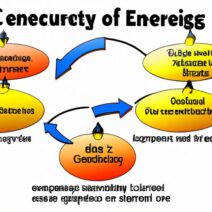Coastal landscapes are dynamic and multifaceted systems, constantly shaped by the relentless forces of nature. How does climate influence these remarkably diverse environments? The interplay between waves, wind, and weathering creates a complex tapestry that underpins the coastal ecosystems we observe today. Understanding this intricate relationship is paramount, not only for environmental scientists but also for anyone with a vested interest in the health of our planet’s shores.
The influence of climate on coastal landscapes primarily manifests through three key elements: waves, wind, and weathering. Each of these forces operates in tandem, sculpting the shorelines and influencing geological processes. The question arises: how will shifting climate conditions alter these relationships in the future? Let us delve deeper into this interplay.
Waves: The Architects of the Shoreline
Waves serve as powerful agents of change and are largely generated by wind pressure acting upon the surface of oceans and seas. The energy of these waves can be dramatic, particularly during storms, leading to significant coastal erosion and reformation of land. Waves are not uniform; their height, speed, and frequency are all affected by climatic conditions, including temperature and atmospheric pressure. Furthermore, climate change is predicted to result in more intense storms, leading to higher swells and more dramatic alterations of coastlines.
Consider a coastal cliff that has stood for millennia. Each wave crashing against it is a testament to the ongoing conversation between land and sea. With rising sea levels and more powerful storms driven by climate change, will these cliffs be mere echoes of their former selves? Perhaps, as erosion accelerates, what was once stable may become a vulnerable, crumbling feature of the landscape. An exploration of these possibilities invites us to consider the resilience of natural environments in the face of adversity.
Wind: The Unsung Influencer
While waves often take center stage in discussions about coastal dynamics, the role of wind should not be underestimated. Wind patterns, closely tied to climatic conditions, influence both wave formation and the deposition of materials along coastlines. Coastal winds can transport sand and sediment, giving rise to landforms such as dunes, barrier islands, and beaches. The direction and intensity of winds play a critical role in the geomorphology of coastal areas.
Wind’s influence extends beyond shaping landforms; it also affects the distribution of flora and fauna on coastlines. For instance, salt marshes and mangrove forests rely on specific wind patterns for pollination and seed dispersal. What happens when these patterns change? Will we witness a dramatic shift in the biodiversity of coastal regions as species struggle to adapt to their newly altered homes? As our climate continues to evolve, so too must our understanding of these vital systems. The potential consequences are profound and warrant careful consideration.
Weathering: The Slow Erosion of Time
Weathering, an inherently slow yet essential process, mechanisms of which are amplified by climate conditions, plays a pivotal role in shaping coastal landscapes. Chemical and physical weathering acts on rocks, breaking them down into sediment that nourishes coastal ecosystems. Factors such as temperature, moisture, and chemical composition—all influenced by climate—affect the rates of weathering. For example, increased rainfall may enhance chemical weathering, while drier conditions can lead to physical disintegration caused by temperature fluctuations.
This process raises an intriguing question: how will accelerated climate change alter the pace at which coastal materials weather and erode? Is it possible that certain landscapes could transform overnight, while others endure surprisingly intact? The implications of such transformations extend beyond geology; they touch on habitat conservation and the resilience of coastal communities, who depend on these environments for their livelihoods.
Impact on Coastal Ecosystems
As climate influences the mechanics of waves, wind, and weathering, it is crucial to consider the broader ecological impacts that unfold. Coastal zones are home to a rich tapestry of biodiversity. Marine organisms, birds, and terrestrial species all rely on these habitats for survival. Changes in coastal landscapes due to climate change can disrupt migration patterns, breeding grounds, and food availability. For example, as a beach erodes, nesting sites for sea turtles may vanish, jeopardizing their reproductive success.
This interconnectedness of climate, coastal morphology, and biodiversity invites a critical challenge for conservationists. How can we enact protective measures to preserve these vital ecosystems as they face mounting pressures from climate change? Adaptive management strategies could facilitate a hopeful outcome for both human communities and the biodiversity that resides within coastal environments. Integrated approaches that marry traditional knowledge with cutting-edge science may yield innovative solutions.
Coastal landscapes are not static; they are manifestations of ongoing processes shaped by climate, each wave, gust of wind, and instance of weathering telling a story of environmental change. The interplay among these elements poses profound challenges and questions. Will our coastal ecosystems thrive amid rising seas and shifting climates, or will they succumb to the relentless march of erosion and change? The answers lie in our collective understanding and action as stewards of the environment.
Ultimately, the future of coastal landscapes hinges on our ability to adapt and respond to the challenges posed by climate influence. The beauty and resilience of these environments depend on our commitment to preserving their integrity amid ever-changing conditions. Together, we can forge a path toward a more sustainable coexistence with our world’s coastlines, ensuring that nature’s enduring legacy continues to inspire and sustain us.



